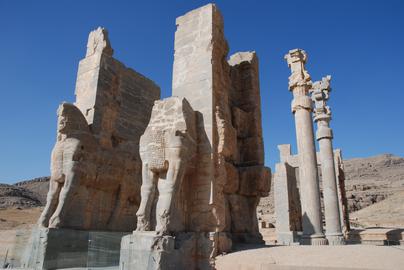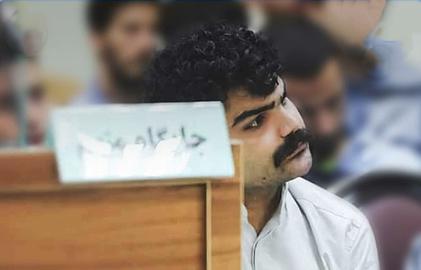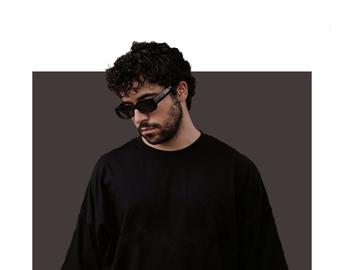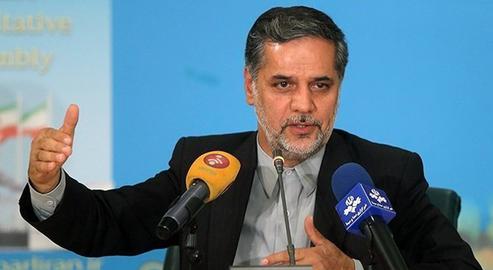If you go to Iran, everyone will ask if you’ve been to Persepolis. This ancient capital of the Achaemenid Empire, founded by the Emperor Darius around 518 BCE, is a national symbol. Listed as a UNESCO World Heritage site, and located about an hour’s drive northeast of the cultural capital of Shiraz, it is also a natural draw for tourists. Images from its well-preserved friezes and sculptures are reproduced in kitsch form throughout Iran, and its stylized eagle heads even adorn the fins of Iran Air jetliners. And while the site's role in the western imagination dates back to the era of Greco-Persian warfare, its modern history — from an international spectacle held by the Shah in 1971 to a fanatic’s threats to destroy it in 1979 — is no less compelling.
The City with Two Names
Persepolis reflects the wealth and glory of the Achaemenid kings, whose empire at its height stretched from Eastern Greece to Afghanistan. Its most striking features include a grand “Gate of all Nations” flanked by winged bulls with the heads of men, an “apadana” or audience hall decorated with friezes showing delegates from subject nations bearing gifts, and ornate looming columns topped with regal bulls and eagles.
The site also contains a labyrinth of stone doorways that once formed part of the palace of the emperor Xerxes, who reigned from 486-465 BCE. It was Xerxes’s wars with Greece that brought Persepolis to ruin, since his rival, Alexander of Macedon, destroyed the site in 330 BCE. Legend holds that Alexander sacked Persepolis during a night of drunken excess, apparently in revenge for the Persian burning of the Acropolis 150 years earlier.

Persepolis in the Qajar era, before modern excavations began
Iranians know Persepolis by two names, “Takht-e Jamshid,” or “Throne of Jamshid,” and Persepolis, which is Greek for “Persian City.” The first name reflects the site’s entry, absent a clear historical record, into Iranian folklore. “For the vast majority of Iranian historical memory,” says Ali Ansari, professor of Iranian studies at the University of St. Andrews, “they have found their ideas of identity from what we would term mythological history.” That mythological history derives from the Shahnameh, or Persian Book of Kings, an epic poem completed by Ferdowsi in 1010, in an effort to preserve Iran’s cultural memory following the Islamic conquests of the 7th century. They ascribed these great ruins at Persepolis to one of the great kings of the Shahnameh, Jamshid.
The second name reflects the site’s identification in 1620 by Garcia De Silva Figueroa, a Portuguese ambassador to the court of Safavid Shah Abbas I, an understanding that formed the basis for subsequent western historical explorations beginning in the 19th century. Far from challenging local sensibilities, the emerging history proved uncannily compatible with Iranian tradition. “What is interesting,” Ansari says, “is that as the Europeans began to reintroduce Iranians to the idea of the Achaemenid kings, it proved a less difficult transition than people might think. Jamshid was meant to be the king of the world, and it wasn't difficult to replace him with the Achaemenid King Cyrus, who was almost king of the world, if you want to put it that way.” While Cyrus predated Persepolis, its founder, Darius, did rule the same empire.

The Oriental Institute of Chicago carries out excavations at Persepolis in 1931
An International Stage
Until the early 20th century, much of Persepolis remained buried, although it did attract travelers. But it was not until 1931 that the Oriental Institute of Chicago launched a series of archeological expeditions. The OIC’s excavations and observations lasted throughout the decade, and revealed beautifully preserved grand staircases, and the so-named Harem of Xerxes, whose iconic stone doorways they were able to reconstruct. The institute hired local people to do the digging, and the effort was well received. While some Iranians did object to archaeologists taking artefacts abroad, Ansari says, many Iranian intellectuals welcomed the rediscovery of ancient Persian kings.

Reza Shah and his son Mohammad Reza visit Persepolis
Iran’s rulers took an interest, too. There exist photographs of Iran’s first Pahlavi shah, Reza Shah, examining Persepolis’s friezes with a young Mohammad Reza — who would succeed him in 1941 — looking over his shoulder. Reza Shah, Ansari says, didn’t make too much of Iran’s Achaemenid history — he was more interested in the Sassanid Empire that existed prior to the Islamic conquests — but his son’s passion for the Achaemenids would prove immense. In 1971, Mohammad Reza Pahlavi – only the second in the Pahlavi line – sought to link himself in the world’s eyes to a 2500 year tradition of Iranian monarchy by holding a grand ceremony at Persepolis.

Spectacle to celebrate 2500 years of monarchy, 1971
The spectacle drew in leaders and B-list monarchs from around the world. After listening to a speech from the Shah at the nearby Tomb of Cyrus at Pasargadae, they attended a parade of costumed figures before the backdrop of Persepolis. Infamously, they later sat down to a pricey meal flown in from Paris in a scene that, with post-revolutionary hindsight, resembled Edgar Allan Poe’s Masque of the Red Death. “The tragedy at the center of it,” Ansari says, “was that the Shah wanted to say that this will be this great Congress of Vienna for the modern age, all these people will come, the world's attention will be on us. What people focused on were things like corruption, human rights, things that the Shah didn't want people to look at.”
A Cultural Stage
More successful and more fondly remembered than the Shah’s spectacle is the annual arts festival that took place in Shiraz and at Persepolis from 1967 to 1977. The Festival of the Arts Shiraz-Persepolis, as it was known, used Persepolis to great effect. “Anybody interested in theater would immediately recognize the epic quality of that space as a stage,” says Vali Mahlouji, curator of a recent exhibition about the festival at the Whitechapel Gallery in London. “The setting for these performances at Persepolis was breath-taking.”

Poster for the Shiraz-Persepolis Arts Festival, 1977
The festival drew in artists — mainly theater troupes and musical performers — from around the world. During the Cold War, Mahlouji says, this was a major diplomatic undertaking, but the festival managed to include talent from the West, from Soviet-dominated eastern bloc countries, and from the developing world. Artists from the US and Europe interacted with counterparts from Asia and Africa. Notable attendees included Ted Hughes and Ravi Shankar.
In the spirit of internationalism, the festival made tasteful if optimistic reference to the Achaemenid themes embodied in the site. “It was a ceremonial capital, as you can see from the Apadana Friezes,” Mahlouji says, referring to depictions of peoples of various nationalities bearing gifts to the Persian kings. “It was a symbol of a unifying platform for all the nations that came together under the construct of the first world empire. It was historically the first time that any state created a kind of federal system that had to operate across many different cultures, nations, geographies and religions. It can easily be appropriated as the backdrop for a utopian stage bringing together expressions from all over the world.”

Performance of Albert Camus’ play Caligula, directed by Arby Ovanessian at Persepolis Arts Festival, 1974
But in 1977, Ayatollah Ruhollah Khomeini, speaking from a mosque in the Shia holy city of Najaf in Iraq, condemned the festival. “It is difficult to speak of,” he said. “Indecent acts have taken place in Shiraz and it is said that such acts will soon be shown in Tehran too, and nobody says a word. The gentlemen [clerics] in Iran don’t say anything. I cannot understand why they don’t speak out!” That year turned out to be the festival’s last. As the Iranian Revolution began to gather momentum the following year, organizers canceled the festival. “Mainly, it was security,” Mahlouji says. “The festival was scapegoated. There were religious decrees that were declaring the festival decadent.” No comparable event has taken place in Iran since the revolution.
An Ideological Blank Slate
The revolution that overthrew the Shah in 1979 also brought a threat to Persepolis in the form of the Islamic cleric and hanging judge, Sadegh Khalkhali. Khalkhali, best known for executing around 8,000 Iranians, had also concocted revolutionary conspiracy theories about Achaemenid history. “Khalkhali had written a book in which he derided this whole cult of Cyrus the Great as a western invention,” Ansari says. “Not only did he call it a western invention, he said it was a Zionist thing. This narrative was held quite strongly by radical Islamists. Thankfully, even the mainstream revolutionaries weren’t going to buy into this.”
Nevertheless, emboldened by his “year zero” mentality and the fear he had inspired across Iran, Khalkhali set out to destroy Persepolis. He met strong popular opposition. “Very large numbers of local people turned out and blocked all the roads around Persepolis,” says John Curtis of the London-based Iran Heritage Society. “They made it absolutely clear that there was no way that they would allow any bulldozers or anything through to the site. It is a remarkable incident of local people protecting their cultural heritage, which hasn't happened in Iraq or Syria. That was a very isolated incident. Most Iranians are very fiercely nationalistic, and have no interest in destroying their heritage.”

Tourists at Persepolis
While there have been other episodes of religiously-motivated iconoclasm targeting Persepolis at various times in Iranian history, Curtis says, Persepolis remains one of the best-preserved relics of the ancient world. Today, he says, the biggest threats to the site are environmental. “There is acid rain, and increasingly there are sandstorms blowing in from the Persian Gulf. There is also another problem, in that there is a petrochemical refinery at Marvdasht, which is about ten kilometres to the southwest. The prevailing winds blow in from Marvdasht straight into Persepolis. Another problem is the very large number of tourists, Iranian tourists mostly, moving around the site.”

Ayatollah Ali Khamenei visits Persepolis
Among those tourists have been most of Iran’s post-revolutionary leaders. Persepolis is now such a popular symbol of Iran that no president has been able to resist a photo op there. “President Akbar Hashemi Rafsanjani started the trend in 1991,” Ansari says. “When he went there, he had to present it as saying that this is what happens wen you become decadent, that empires rise and fall. But people criticized him because he was clearly moved.” Even Supreme Leader Ayatollah Ali Khamenei has also been photographed at the site with his entourage. Khamenei has struggled to decide what to say about the site, calling it both “a symbol of godlessness” and “a source of pride for the Iranian nation.”

President Hassan Rouhani visits Persepolis in 2015
But President Hassan Rouhani, who visited Persepolis in 2015 and published photos on his website, knows exactly what his public wants. He presented the site as an unambiguous symbol of Iranian ingenuity and achievement, and proof of great things to come. One wonders, though: if the ancient kings could see Iran now, what would they think of him?
This article was originally published on March 11, 2016
visit the accountability section
In this section of Iran Wire, you can contact the officials and launch your campaign for various problems

























comments